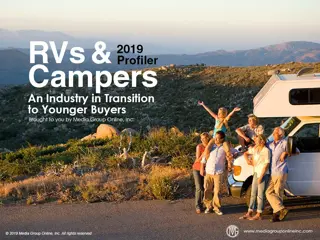Trends in the RV Industry: Challenges and Shifts Toward Younger Buyers
Sustaining peak shipment numbers in the RV industry has proven challenging, with a decline projected for 2019 and 2020. Dealers have managed excess inventory through sales, reflecting varied outlooks. Ownership trends show a skew towards younger buyers, particularly Millennials and Gen Xers, influencing market dynamics. Younger enthusiasts are increasingly exploring RV rentals and driving the aftermarket parts and accessories market, indicating a shift in consumer preferences.
Download Presentation

Please find below an Image/Link to download the presentation.
The content on the website is provided AS IS for your information and personal use only. It may not be sold, licensed, or shared on other websites without obtaining consent from the author. Download presentation by click this link. If you encounter any issues during the download, it is possible that the publisher has removed the file from their server.
E N D
Presentation Transcript
Finding It Difficult To Sustain Peak Shipment Numbers The RV industry wishes this old saw didn t apply to it, but after a steady and significant increase in total annual shipments from 2009 s 165,600 units to 2017 s all-time high of 504,600, the 2019 total is expected to be 402,100 units, a 16.9% decrease from 2018. As is so often the case, the industry was high on its success, so manufacturers opened more plants, hired more workers and shipped more inventory to dealers. The upside is dealers have somewhat alleviated this situation by selling excess inventory. The RV Industry Association (RVIA) is projecting total 2020 shipments to be 386,400 units, or another decrease, but only 3.9%. Some industry leaders have stated the correction was inevitable given the rapid increases during the past 5 years.
Dealers Hold the Line According to an August 2019 dealer survey from RVBusiness and RV Trader, which generated more than 100 responses, only 26% said their 2019 retail sales were somewhat better than 2018 while 20% said mediocre and 19% disappointing. Their 2020 outlooks were a bit more optimistic, as 37% said they were guardedly upbeat ; 22% very optimistic ; 25% flat ; 14% underperforming ; and 2% unacceptably low. Since most dealers were able to sell their excess inventory, 53% said they were generally satisfied with their new-unit inventory while 30% said they had too much and 17% said they don t have enough.
Ownership Profile Continues to Skew Younger During fall 2019, RV Trader released its latest report about RV buyers based on its millions of data points and indicated the majority (53%) of buyers were 55 or younger, divided equally between Millennials (21 35), 26%, and Gen Xers (36 55), 27%. Another important ownership trend from the report s buyer profile of those consumers who purchased an RV during the past two years is 59% of them were women. Plus, 79% of all buyers were married and 44% earned $50K $100K annually. Unsurprisingly, the largest percentage (67% 70%) said they bought an RV for a family vacation, camping trip or road trip. An almost equal percentage (66%) said they wanted sleeping accommodation wherever they traveled.
Younger RV Enthusiasts Test the Road Via Rentals The RV industry is in the midst of a major transition from Baby Boomers and older seniors as the primary buyer segment to Millennials and Gen Xers, a trend that probably bears some responsibility for the current volatility of the market. Another accelerating trend revealed in the RV Trader data points is 63% of RV renters are Millennials or younger. Of even greater importance is 76% of renters said they were likely to purchase an RV within two years. Younger RV owners are also driving the parts and accessories market. RVIA s 2019 Aftermarket Parts and Accessories Customer Survey revealed 49% of owners 30 49 are likely to upgrade plumbing, and 43% electrical, larger percentages than older owners.
Motorhomes Continue to Drive in the Traditional Lane Data published in recent issues of RVBusiness clearly indicates the primary buyers of motorhomes, especially Class A, are older and are in average to above-average income brackets and women are almost as likely to be a buyer as men in older age ranges. In fact, larger percentages of women than men in the 55 64 age group are buyers of Class A, 35.03% vs. 33.19%; Class B, 33.67% vs. 32.03%; and Class C, 34.26% vs. 30.95%, respectively. The RV Trader data cited on page 2 of the Profiler also revealed today s RV buyers want larger vehicles, with 43% considering the purchase of a Class A motorhome and 37% a Class C, however, much fewer, or 23%, are planning to buy a Class B motorhome.
Finding New Roads RV manufacturers are taking the initiative to design and build models that reflect current and future trends, including more solar-assisted battery systems, an expanding array of all-electric units and advanced, lightweight materials to improve fuel economy. Other trends that will affect the industry and many will give it a boost include significant expansion of RV parks and campgrounds and more Americans using an RV as a primary residence, even those of considerable income. Industry leaders and analysts expect more dealers to increase their use of social media and other digital marketing channels in response to the growing number of younger adults becoming RV buyers.
Advertising Strategies For a number of years, TV will still be a primary ad medium to reach the older audience that is still the bulk of RV, and especially motorhome, buyers. An angle for dealers to consider is featuring units and accessories for the increasing number of people who live in their RVs. Because many dealers were able to sell their excess inventory, heavy discounts are probably not necessary, but they should create (with your assistance) unique promotions, such as accessories packages, etc. to reinvigorate the local market.
New Media Strategies With more young adults becoming RV enthusiasts and owners, dealers will need to add Instagram and Snapchat to their social media strategy. They should consider asking younger customers to become local influencers and share their perspectives on RVing. Since younger adult owners of RVs purchase a significant portion of parts and accessories, invite your customers to post short videos on social media showing what parts or accessories they bought and how they enhance/improve their RV experience. Similarly, invite customers and all RVers who live and work in their vehicle exclusively, as many freelancers and gig economy workers do, to share their stories with short videos: why an RV lifestyle complements their work so well, how much money they save, etc.



























